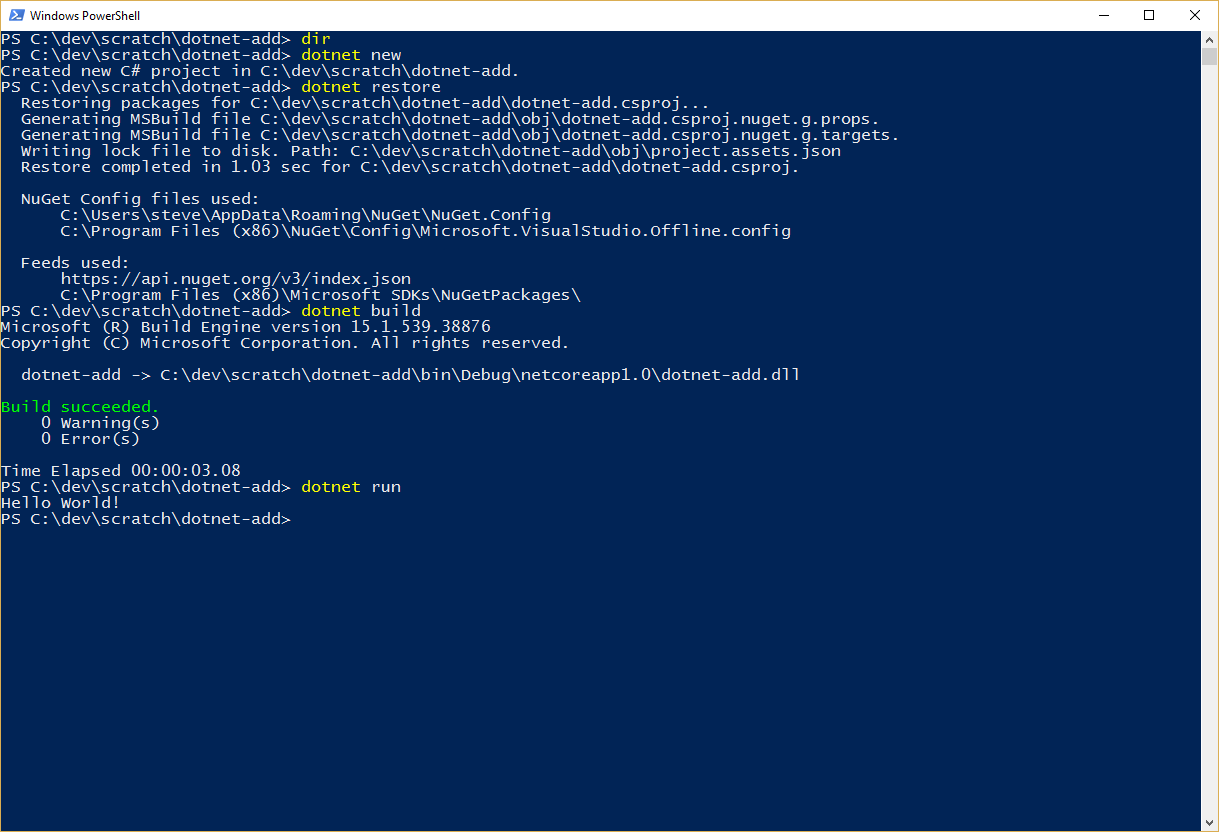See Ways to install NuGet packages. To work with NuGet, as a package consumer or creator, you can use command-line interface (CLI) tools as well as NuGet features in Visual Studio. This article briefly outlines the capabilities of the different tools, how to install them, and their comparative feature availability. To use or install package manually, go to Tools- Options- NuGet Package Manager- Package Sources. Click the Add button, choose the Source, and don't forget to click 'Update' as it will update the folder location for your packages, edit your desired Name of your package source if.
-->This article applies to: ✔️ .NET Core 2.x SDK and later versions


Name
dotnet add package - Adds a package reference to a project file.
Dotnet Cli Install Package
Synopsis
Description
The dotnet add package command provides a convenient option to add a package reference to a project file. After running the command, there's a compatibility check to ensure the package is compatible with the frameworks in the project. If the check passes, a element is added to the project file and dotnet restore is run.
For example, adding Newtonsoft.Json to ToDo.csproj produces output similar to the following example:
The ToDo.csproj file now contains a element for the referenced package.
Implicit restore
You don't have to run dotnet restore because it's run implicitly by all commands that require a restore to occur, such as dotnet new, dotnet build, dotnet run, dotnet test, dotnet publish, and dotnet pack. To disable implicit restore, use the --no-restore option.
The dotnet restore command is still useful in certain scenarios where explicitly restoring makes sense, such as continuous integration builds in Azure DevOps Services or in build systems that need to explicitly control when the restore occurs.
For information about how to manage NuGet feeds, see the dotnet restore documentation.
Arguments
PROJECTSpecifies the project file. If not specified, the command searches the current directory for one.
PACKAGE_NAMEThe package reference to add.
Install Nuget Package Dotnet Cli Commands
Options
Dotnet Install Local Nuget Package
-f|--frameworkAdds a package reference only when targeting a specific framework.
-h|--helpPrints out a short help for the command.
--interactiveAllows the command to stop and wait for user input or action (for example, to complete authentication). Available since .NET Core 2.1 SDK, version 2.1.400 or later.
-n|--no-restoreAdds a package reference without performing a restore preview and compatibility check.
--package-directoryThe directory where to restore the packages. The default package restore location is
%userprofile%.nugetpackageson Windows and~/.nuget/packageson macOS and Linux. For more information, see Managing the global packages, cache, and temp folders in NuGet.--prereleaseAllows prerelease packages to be installed.
-s|--sourceThe URI of the NuGet package source to use during the restore operation.
-v|--versionVersion of the package. See NuGet package versioning.
Examples


Name
dotnet add package - Adds a package reference to a project file.
Dotnet Cli Install Package
Synopsis
Description
The dotnet add package command provides a convenient option to add a package reference to a project file. After running the command, there's a compatibility check to ensure the package is compatible with the frameworks in the project. If the check passes, a element is added to the project file and dotnet restore is run.
For example, adding Newtonsoft.Json to ToDo.csproj produces output similar to the following example:
The ToDo.csproj file now contains a element for the referenced package.
Implicit restore
You don't have to run dotnet restore because it's run implicitly by all commands that require a restore to occur, such as dotnet new, dotnet build, dotnet run, dotnet test, dotnet publish, and dotnet pack. To disable implicit restore, use the --no-restore option.
The dotnet restore command is still useful in certain scenarios where explicitly restoring makes sense, such as continuous integration builds in Azure DevOps Services or in build systems that need to explicitly control when the restore occurs.
For information about how to manage NuGet feeds, see the dotnet restore documentation.
Arguments
PROJECTSpecifies the project file. If not specified, the command searches the current directory for one.
PACKAGE_NAMEThe package reference to add.
Install Nuget Package Dotnet Cli Commands
Options
Dotnet Install Local Nuget Package
-f|--frameworkAdds a package reference only when targeting a specific framework.
-h|--helpPrints out a short help for the command.
--interactiveAllows the command to stop and wait for user input or action (for example, to complete authentication). Available since .NET Core 2.1 SDK, version 2.1.400 or later.
-n|--no-restoreAdds a package reference without performing a restore preview and compatibility check.
--package-directoryThe directory where to restore the packages. The default package restore location is
%userprofile%.nugetpackageson Windows and~/.nuget/packageson macOS and Linux. For more information, see Managing the global packages, cache, and temp folders in NuGet.--prereleaseAllows prerelease packages to be installed.
-s|--sourceThe URI of the NuGet package source to use during the restore operation.
-v|--versionVersion of the package. See NuGet package versioning.
Examples
Dotnet Install Nuget Package
Add
Newtonsoft.JsonNuGet package to a project:Add a specific version of a package to a project:
Add a package using a specific NuGet source:
